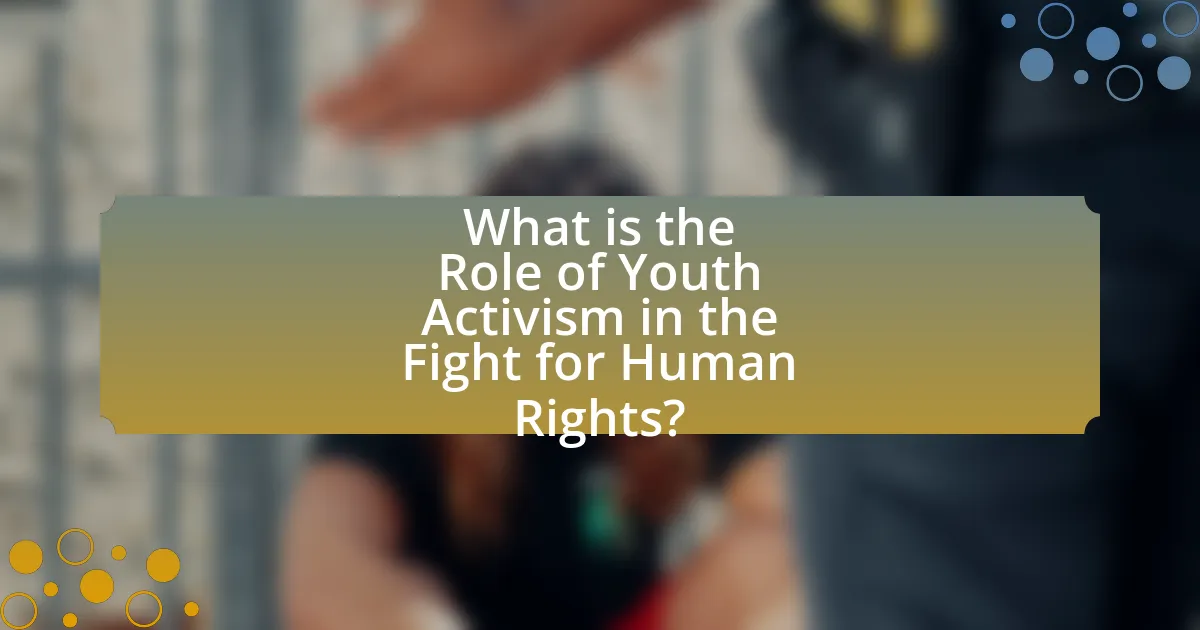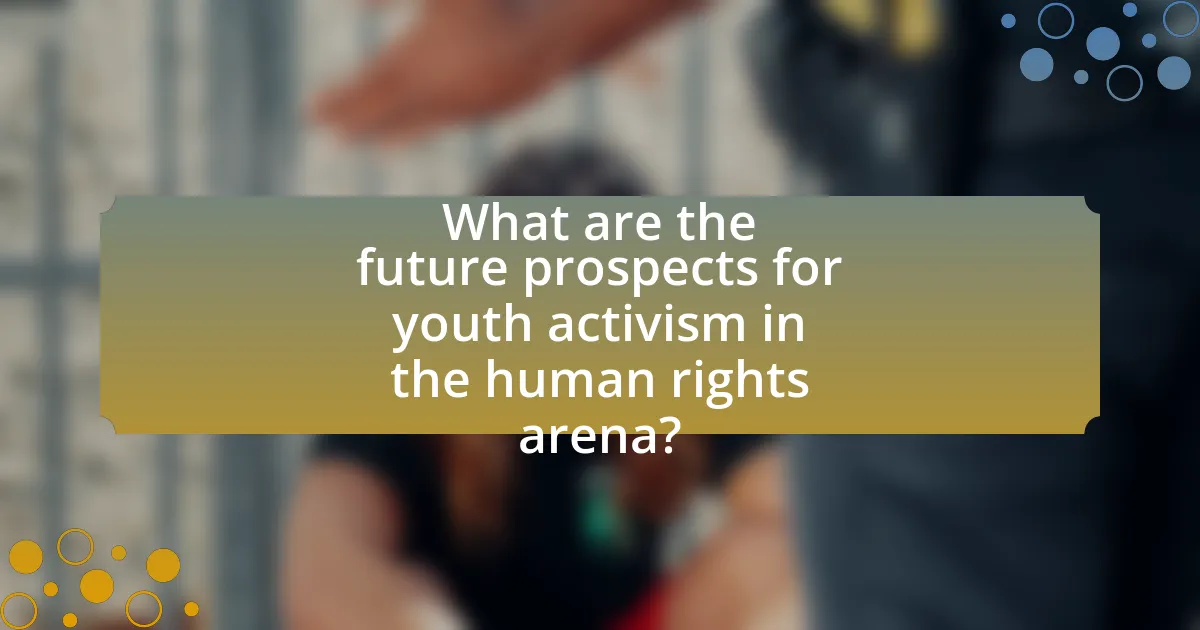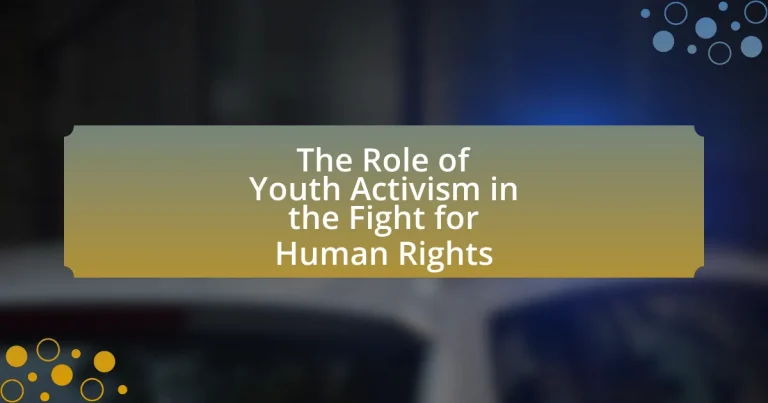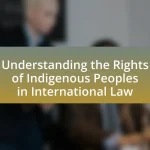Youth activism is a vital force in the fight for human rights, mobilizing young individuals to advocate for social change and raise awareness about various injustices. The article explores the evolution of youth activism, highlighting historical events that have shaped its trajectory, such as the Civil Rights Movement and the anti-apartheid struggle. It examines the influence of cultural and social factors on youth engagement, the unique perspectives young activists bring to human rights issues, and the challenges they face, including systemic barriers and societal pushback. Additionally, the article discusses the role of technology and social media in amplifying youth-led movements, the importance of intersectionality in advocacy, and the future prospects for youth activism in addressing emerging global issues.

What is the Role of Youth Activism in the Fight for Human Rights?
Youth activism plays a crucial role in the fight for human rights by mobilizing young people to advocate for social change and raise awareness about injustices. This demographic often utilizes social media platforms to amplify their voices, organize protests, and engage in campaigns that highlight issues such as climate change, racial equality, and gender rights. For instance, the global climate strikes initiated by Greta Thunberg in 2018 galvanized millions of young activists worldwide, demonstrating their capacity to influence public discourse and policy. Additionally, studies show that youth-led movements can lead to significant legislative changes, as seen in the advocacy for gun control following the Parkland shooting in the United States. Thus, youth activism not only fosters community engagement but also drives systemic change in the pursuit of human rights.
How has youth activism evolved in the context of human rights?
Youth activism has evolved significantly in the context of human rights, transitioning from localized efforts to global movements facilitated by technology and social media. Historically, youth activism focused on specific issues such as civil rights and anti-war protests, exemplified by the 1960s movements in the United States. In recent years, youth have leveraged platforms like Twitter and Instagram to mobilize for broader human rights issues, including climate justice, racial equality, and gender rights, as seen in movements like Black Lives Matter and Fridays for Future. This evolution is evidenced by the increased participation of young people in international forums, such as the United Nations, where they advocate for policy changes and hold leaders accountable. The rise of youth-led organizations and initiatives, such as the Global Youth Climate Network, further illustrates this shift, demonstrating a collective commitment to addressing systemic injustices on a global scale.
What historical events have shaped youth activism for human rights?
Historical events that have shaped youth activism for human rights include the Civil Rights Movement in the United States during the 1950s and 1960s, which saw young activists like John Lewis and the Student Nonviolent Coordinating Committee (SNCC) leading protests against racial segregation and discrimination. The anti-apartheid movement in South Africa, particularly the Soweto Uprising in 1976, where students protested against the imposition of Afrikaans in schools, also significantly influenced youth activism globally. Additionally, the global response to the Vietnam War in the 1960s mobilized young people to advocate for peace and social justice, while the rise of digital technology in the 21st century has enabled youth to organize and amplify their voices through social media platforms, as seen in movements like Black Lives Matter and climate activism led by figures like Greta Thunberg. These events collectively demonstrate how youth have historically played a crucial role in advocating for human rights through organized activism and social movements.
How do cultural and social factors influence youth activism?
Cultural and social factors significantly influence youth activism by shaping the values, beliefs, and motivations of young individuals. For instance, cultural norms around social justice and community engagement can inspire youth to mobilize for causes such as climate change, racial equality, and gender rights. Social media platforms, which are integral to youth culture, facilitate the rapid dissemination of information and foster connections among like-minded individuals, amplifying their voices and collective action. Research indicates that youth who engage in activism often cite peer influence and community support as critical motivators, highlighting the role of social networks in encouraging participation. Additionally, cultural narratives and historical contexts, such as movements for civil rights or environmental justice, provide frameworks that resonate with youth, motivating them to advocate for change.
Why is youth activism crucial in the fight for human rights?
Youth activism is crucial in the fight for human rights because it brings fresh perspectives and energy to social movements, often leading to significant change. Young activists are typically more adept at utilizing social media and technology to mobilize support, raise awareness, and influence public opinion. For instance, the global climate strikes initiated by youth activists in 2019, led by figures like Greta Thunberg, demonstrated how young voices can galvanize millions and pressure governments to take action on pressing issues. Furthermore, studies show that youth-led movements have historically played pivotal roles in advancing civil rights, such as the 1960s civil rights movement in the United States, where young people were instrumental in organizing protests and advocating for legislative change. Thus, the involvement of youth in activism not only enhances the visibility of human rights issues but also fosters a sense of responsibility and empowerment among future generations.
What unique perspectives do young activists bring to human rights issues?
Young activists bring fresh, innovative perspectives to human rights issues by leveraging technology and social media to mobilize support and raise awareness. Their adeptness with digital platforms allows them to reach a global audience quickly, as seen in movements like #BlackLivesMatter and #FridaysForFuture, which gained traction through online engagement. Additionally, young activists often challenge traditional narratives and advocate for intersectionality, emphasizing the interconnectedness of various social justice issues. This approach is evident in the work of activists like Malala Yousafzai, who highlights the importance of education in combating gender inequality and poverty. Their unique perspectives are shaped by their experiences and the urgency of addressing contemporary challenges, making them vital contributors to the human rights discourse.
How does youth activism impact policy changes and societal norms?
Youth activism significantly impacts policy changes and societal norms by mobilizing collective action and raising awareness on critical issues. For instance, movements like March for Our Lives, initiated by students after the Parkland shooting, successfully advocated for gun control legislation in several states, demonstrating how organized youth efforts can lead to tangible policy reforms. Additionally, youth-led climate strikes, inspired by Greta Thunberg, have shifted public discourse and pressured governments worldwide to adopt more aggressive climate policies, illustrating the power of youth voices in shaping societal values and expectations. These examples underscore that youth activism not only influences legislative outcomes but also fosters a cultural shift towards greater accountability and social justice.
What challenges do youth activists face in advocating for human rights?
Youth activists face significant challenges in advocating for human rights, including limited access to resources, lack of political influence, and societal pushback. Limited funding and support hinder their ability to organize campaigns and reach wider audiences. Additionally, youth often lack the political power and connections that established activists possess, making it difficult to effect change within governmental structures. Societal pushback can manifest as criticism or hostility from adults and institutions, which may undermine their credibility and efforts. These challenges are documented in various studies, such as the “Youth Activism and Human Rights” report by the United Nations, which highlights the barriers young people encounter in their advocacy work.
What are the common obstacles encountered by young activists?
Young activists commonly encounter obstacles such as lack of funding, limited access to platforms for their voices, and generational divides in understanding issues. Funding challenges arise because many young activists operate on tight budgets, making it difficult to sustain campaigns or initiatives. Limited access to platforms can hinder their ability to reach wider audiences, as traditional media often overlooks youth-led movements. Additionally, generational divides can create misunderstandings or resistance from older generations, who may not fully grasp the urgency or relevance of the issues young activists are addressing. These obstacles can significantly impede the effectiveness and reach of youth activism in the fight for human rights.
How do systemic barriers affect the effectiveness of youth activism?
Systemic barriers significantly hinder the effectiveness of youth activism by limiting access to resources, decision-making processes, and platforms for expression. These barriers include socioeconomic disparities, institutional discrimination, and legal restrictions that disproportionately affect young activists. For instance, youth from marginalized communities often lack funding and support, which restricts their ability to organize and mobilize effectively. Additionally, systemic barriers such as age-related legal constraints can prevent young activists from participating fully in political processes, thereby diminishing their impact on human rights advocacy. Research indicates that youth activism is more successful when these barriers are addressed, as seen in movements like the March for Our Lives, which gained traction by overcoming institutional obstacles through strategic alliances and community support.
How can youth activism be supported and amplified?
Youth activism can be supported and amplified through targeted mentorship programs, funding opportunities, and access to platforms for expression. Mentorship programs connect young activists with experienced leaders, enhancing their skills and networks, as evidenced by initiatives like the Youth Leadership Program by the United Nations, which has successfully empowered youth in various regions. Funding opportunities, such as grants from organizations like the Global Fund for Community Foundations, provide financial resources that enable youth-led projects to thrive. Additionally, creating accessible platforms for expression, such as social media campaigns and community forums, allows youth to share their messages widely, as demonstrated by the global reach of movements like #FridaysForFuture, which mobilized millions for climate action.
What role do educational institutions play in fostering youth activism?
Educational institutions play a crucial role in fostering youth activism by providing a platform for education, critical thinking, and civic engagement. They encourage students to explore social issues, develop leadership skills, and participate in community service, which are essential components of activism. For instance, programs like debate clubs, student government, and service-learning initiatives empower students to voice their opinions and take action on issues they care about. Research from the National Youth Leadership Council indicates that students involved in service-learning are more likely to engage in civic activities and advocacy, demonstrating the effectiveness of educational settings in promoting activism.
How can technology enhance the reach and impact of youth-led movements?
Technology enhances the reach and impact of youth-led movements by facilitating communication, mobilization, and awareness on a global scale. Social media platforms, such as Twitter and Instagram, allow youth activists to share their messages rapidly, reaching millions of people instantly. For instance, the #FridaysForFuture movement, initiated by Greta Thunberg, gained international attention and participation through social media, mobilizing youth across various countries to advocate for climate action. Additionally, technology enables the organization of virtual events and campaigns, which can engage a wider audience without geographical limitations. According to a study by the Pew Research Center, 72% of teens use social media, making it a powerful tool for youth-led movements to connect, collaborate, and amplify their voices effectively.

What are the key strategies employed by youth activists in human rights campaigns?
Youth activists employ several key strategies in human rights campaigns, including grassroots organizing, digital advocacy, and coalition-building. Grassroots organizing involves mobilizing local communities to raise awareness and drive action on human rights issues, exemplified by movements like Black Lives Matter, which began as a local response to police violence and grew into a global phenomenon. Digital advocacy leverages social media platforms to amplify messages, engage supporters, and mobilize protests, as seen in the global reach of the #MeToo movement. Coalition-building is crucial for uniting diverse groups around common goals, enhancing the impact of campaigns, as demonstrated by youth-led climate strikes that brought together environmentalists, social justice advocates, and students. These strategies collectively empower youth to challenge injustices and promote human rights effectively.
How do youth activists utilize social media for advocacy?
Youth activists utilize social media for advocacy by leveraging platforms to raise awareness, mobilize support, and engage in dialogue on human rights issues. They create and share content that highlights injustices, such as videos, infographics, and personal stories, which can reach a global audience rapidly. For instance, movements like #BlackLivesMatter and #FridaysForFuture have effectively used social media to organize protests and campaigns, demonstrating the power of online engagement in driving real-world action. Research indicates that 79% of young people believe social media is an effective tool for activism, showcasing its significance in contemporary advocacy efforts.
What platforms are most effective for youth activism?
Social media platforms, particularly Instagram, Twitter, and TikTok, are the most effective for youth activism. These platforms enable rapid information dissemination, foster community engagement, and allow for creative expression, which resonates with younger audiences. For instance, a study by the Pew Research Center found that 69% of teens use Instagram, making it a vital space for sharing activism-related content. Additionally, Twitter’s real-time communication facilitates the organization of events and mobilization efforts, while TikTok’s viral nature allows for impactful storytelling and awareness campaigns.
How does online engagement translate to offline action?
Online engagement translates to offline action by mobilizing individuals to participate in real-world activities, such as protests or community service. For instance, social media campaigns can raise awareness about human rights issues, leading to increased attendance at events like marches or rallies. A study by the Pew Research Center found that 69% of social media users have engaged in offline activism after being inspired by online content. This demonstrates a direct correlation between online interactions and tangible actions in the physical world, highlighting the effectiveness of digital platforms in fostering civic engagement among youth activists.
What collaborative efforts exist between youth activists and established organizations?
Collaborative efforts between youth activists and established organizations include partnerships for advocacy campaigns, joint events, and mentorship programs. For instance, organizations like Amnesty International and the United Nations have engaged youth activists in initiatives such as the “Youth for Human Rights” campaign, which empowers young people to advocate for their rights and those of others. Additionally, many established NGOs provide platforms for youth-led movements, facilitating access to resources and networks that amplify their voices. These collaborations often result in increased visibility for youth issues and enhanced impact on policy changes, as seen in movements like the Global Climate Strike, where youth activists worked alongside environmental organizations to demand action on climate change.
How do partnerships enhance the effectiveness of youth-led initiatives?
Partnerships enhance the effectiveness of youth-led initiatives by providing access to resources, expertise, and networks that amplify their impact. Collaborating with established organizations allows youth activists to leverage funding, mentorship, and training opportunities, which can significantly improve project outcomes. For instance, a study by the United Nations Development Programme highlights that youth organizations that partner with NGOs see a 30% increase in project success rates due to shared knowledge and resources. Additionally, partnerships facilitate broader outreach, enabling youth-led initiatives to engage a larger audience and influence policy changes more effectively.
What are examples of successful collaborations in human rights activism?
Successful collaborations in human rights activism include the partnership between the Black Lives Matter movement and various civil rights organizations, which has effectively mobilized protests and policy changes against systemic racism. Another example is the collaboration between Amnesty International and local grassroots organizations, which has led to significant campaigns for the release of political prisoners and the protection of human rights defenders globally. Additionally, the joint efforts of youth-led movements like Fridays for Future and established environmental organizations have highlighted the intersection of climate justice and human rights, resulting in increased awareness and policy advocacy. These collaborations demonstrate the power of collective action in advancing human rights initiatives.
What role does intersectionality play in youth activism for human rights?
Intersectionality plays a crucial role in youth activism for human rights by recognizing and addressing the interconnected nature of social categorizations such as race, gender, sexuality, and class. This framework allows young activists to understand how various forms of discrimination and privilege overlap, leading to more inclusive and effective advocacy. For instance, the Black Lives Matter movement, which was significantly driven by youth, highlights how racial injustice intersects with issues like police brutality and economic inequality, demonstrating that addressing one aspect of oppression requires acknowledging others. Research by Crenshaw (1989) introduced the concept of intersectionality, emphasizing that a singular focus on one identity can overlook the complexities faced by individuals with multiple marginalized identities. This understanding enhances the effectiveness of youth-led movements by fostering solidarity and collaboration among diverse groups, ultimately strengthening the fight for comprehensive human rights.
How do various identities influence youth activism approaches?
Various identities significantly influence youth activism approaches by shaping the perspectives, priorities, and methods of engagement among young activists. For instance, research indicates that factors such as race, gender, socioeconomic status, and sexual orientation can dictate the issues youth prioritize, the strategies they employ, and the communities they mobilize. A study by the Harvard Kennedy School found that Black youth are more likely to engage in activism focused on racial justice, while LGBTQ+ youth often prioritize issues related to equality and representation. These identity-based influences lead to diverse activism styles, such as grassroots organizing, digital campaigns, or coalition-building, reflecting the unique experiences and challenges faced by different identity groups.
What are the implications of intersectional activism on broader human rights movements?
Intersectional activism significantly enhances broader human rights movements by addressing the diverse and overlapping identities that individuals possess, which can lead to more inclusive and effective advocacy. This approach recognizes that issues such as race, gender, sexuality, and class intersect, creating unique experiences of oppression that traditional human rights frameworks may overlook. For instance, the Black Lives Matter movement incorporates intersectional perspectives by highlighting how systemic racism affects Black women differently than Black men, thereby broadening the conversation around police violence and social justice. Research by Crenshaw (1989) on intersectionality illustrates that failing to consider these intersecting identities can result in inadequate solutions that do not fully address the needs of marginalized groups. Consequently, intersectional activism not only amplifies the voices of those who are often silenced but also fosters solidarity among various movements, ultimately strengthening the fight for universal human rights.

What are the future prospects for youth activism in the human rights arena?
The future prospects for youth activism in the human rights arena are promising, driven by increased digital engagement and global connectivity. Young activists are leveraging social media platforms to mobilize support, raise awareness, and influence policy changes, as evidenced by movements like Black Lives Matter and Fridays for Future. According to a 2021 report by the United Nations, youth-led initiatives have significantly impacted global discussions on climate change and social justice, highlighting their potential to shape future human rights agendas. Furthermore, the growing recognition of youth voices in international forums, such as the UN Youth Climate Summit, underscores their critical role in advocating for human rights and social equity.
How can youth activism adapt to changing global dynamics?
Youth activism can adapt to changing global dynamics by leveraging digital platforms for mobilization and awareness. The rise of social media has transformed how young activists communicate, allowing them to reach a global audience instantly and organize movements effectively. For instance, the #FridaysForFuture movement, initiated by Greta Thunberg, utilized social media to galvanize millions of young people worldwide to advocate for climate action, demonstrating the power of digital engagement in contemporary activism. Additionally, youth activists can form coalitions across borders to address global issues collectively, as seen in the collaboration between various youth-led organizations during the United Nations Climate Change Conferences. This adaptability ensures that youth activism remains relevant and impactful in an ever-evolving global landscape.
What emerging issues are likely to shape future youth activism?
Emerging issues likely to shape future youth activism include climate change, social justice, mental health awareness, and digital rights. Climate change is a pressing concern, with youth movements like Fridays for Future mobilizing millions globally to demand action from governments. Social justice issues, including racial equality and gender rights, are increasingly central to youth activism, as seen in movements like Black Lives Matter, which have gained significant traction and support among younger generations. Mental health awareness is becoming a critical topic, with young activists advocating for better mental health resources and destigmatization of mental health issues. Additionally, digital rights, including privacy and freedom of expression online, are vital as youth navigate an increasingly digital world, leading to movements advocating for stronger protections against surveillance and data exploitation. These issues reflect the evolving priorities of youth and their commitment to addressing systemic challenges in society.
How can young activists prepare for future challenges in human rights advocacy?
Young activists can prepare for future challenges in human rights advocacy by developing strong communication skills, building coalitions, and staying informed about global human rights issues. Effective communication enables activists to articulate their messages clearly and mobilize support, as demonstrated by successful campaigns like the #MeToo movement, which utilized social media to raise awareness and foster solidarity. Building coalitions with diverse groups enhances the impact of advocacy efforts, as seen in the collaboration between environmental and social justice movements, which has broadened the reach and effectiveness of their initiatives. Staying informed through continuous education and engagement with current events allows activists to adapt their strategies to emerging challenges, ensuring that their advocacy remains relevant and impactful.
What practical steps can young people take to engage in human rights activism?
Young people can engage in human rights activism by educating themselves about human rights issues and advocating for change within their communities. They can start by researching local and global human rights violations, understanding the legal frameworks that protect rights, and identifying organizations that focus on these issues. For instance, participating in workshops or online courses offered by organizations like Amnesty International can provide valuable insights and skills. Additionally, young activists can use social media platforms to raise awareness, mobilize peers, and share information about campaigns or events. According to a 2021 report by the United Nations, youth-led movements have significantly influenced policy changes, demonstrating the impact of grassroots activism. Engaging in peaceful protests, volunteering for human rights organizations, and collaborating with local leaders can further amplify their efforts and contribute to meaningful change.
What resources are available for youth interested in activism?
Youth interested in activism can access various resources, including organizations, online platforms, and educational materials. Organizations such as Amnesty International and the Sierra Club provide training, mentorship, and opportunities for youth to engage in activism. Online platforms like Change.org and social media channels offer tools for organizing campaigns and raising awareness. Educational materials, including books and documentaries on social justice issues, further equip young activists with knowledge and strategies. These resources collectively empower youth to effectively participate in the fight for human rights.
How can individuals effectively mobilize their peers for human rights causes?
Individuals can effectively mobilize their peers for human rights causes by utilizing social media platforms to raise awareness and foster community engagement. Research indicates that social media campaigns can significantly increase participation in human rights initiatives; for instance, the #BlackLivesMatter movement gained momentum through platforms like Twitter and Instagram, leading to widespread protests and policy discussions. By sharing informative content, personal stories, and calls to action, individuals can inspire their peers to join the cause and participate in events, thereby amplifying their collective impact on human rights issues.


